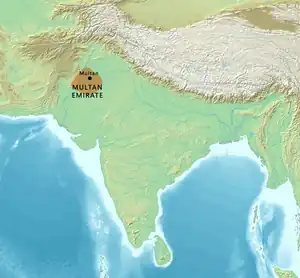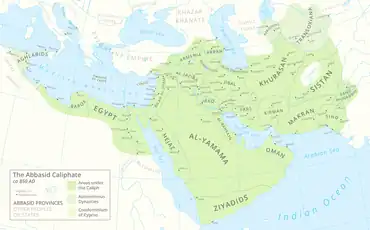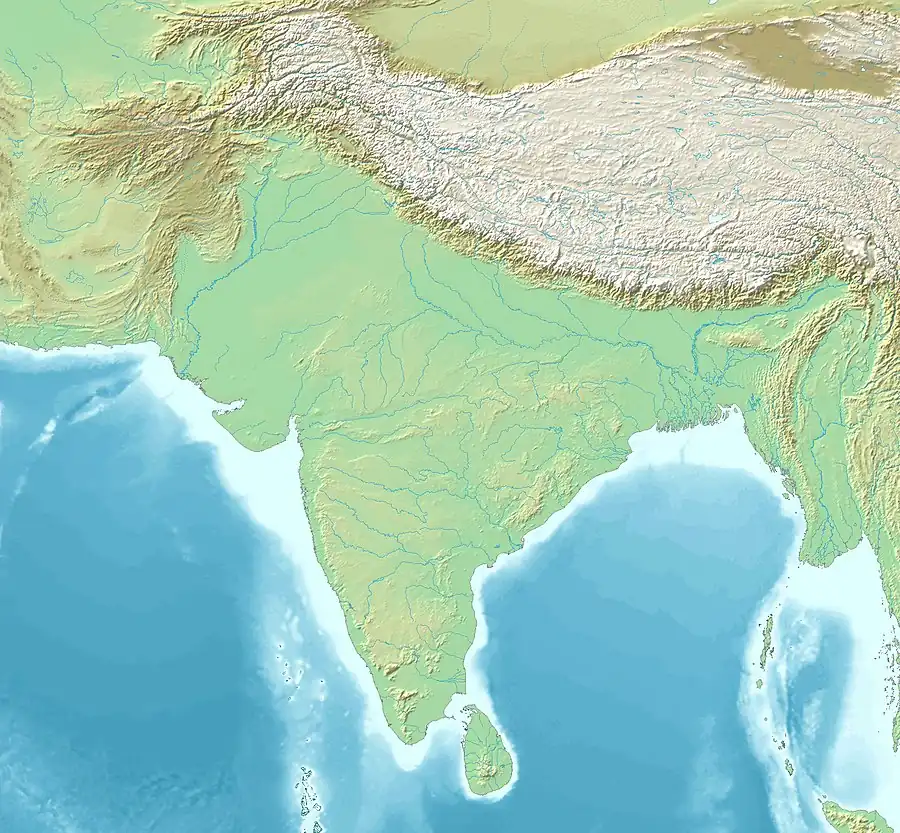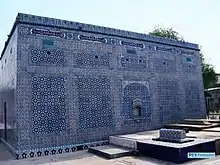Emirate of Multan | |||||||||
|---|---|---|---|---|---|---|---|---|---|
| 855–1010 | |||||||||
 Coinage of Emir Munabbih I, flourished 912-3 CE. Obverse: śri adi/ varāha ("Lord Adi Varaha", an avatar of Vishnu) in Brahmi in two lines.[1] Reverse: Three pellets; lillah munabbih in Arabic below.[3]
| |||||||||
 Map of the Multan Emirate circa 900 CE. | |||||||||
| Capital | Multan | ||||||||
| Religion | Islam | ||||||||
| Government | Emirate | ||||||||
| History | |||||||||
• Munabbih I came to power under Abbasid Caliphate | 855 | ||||||||
| 861 | |||||||||
• Banu Lawi overthrew the Banu Munabbih | 959 | ||||||||
• Emirate of Multan ends | 1010 | ||||||||
| |||||||||
| Today part of | Punjab, Pakistan | ||||||||
Emirate of Multan (855 – 1010) was a medieval Muslim kingdom in Punjab that was centred around city of Multan, present-day part of Punjab, Pakistan. It was initially ruled by the tribe of Banu Munabbih. In 959 CE, Ismaili Qarmatians under Banu Lawi gained control of the Emirate and in 1010, it was conquered by Ghaznavid Empire.[4]
Location
The Emirate of Multan became independent after Disintegration of Abbasid Caliphate. Principally located in South Punjab, it bordered Hindu Shahi Kingdom at north in Punjab and Habbarid Emirate at south in Sindh.
History
Multan along with Sindh came under rule of Muslims by conquest of Umayyad Caliphate under General Muhammad Bin Qasim. Over the course of the mid-ninth century, Abbasid authority in Sind gradually waned. As the central government's authority over Sind declined, the region underwent a period of decentralization.[5] Multan also became capital of an independent emirate under an Arab tribe Banu Munabbih.
Banu Munabbih (855–959 AD)
By the mid-800s, the Banu Munabbih (also known as the Banu Sama), who claimed descent from the Prophet Muhammad's Quraysh tribe came to rule Multan, and established the Emirate, which ruled for the next century.[6] At the opening of 10th century, Ibn Rusta was first to report a well established Emirate in Multan. Muhammad III, whose full name was Muhammad bin al-Qasim bin Munabbih, was reported by Al-Biruni to be the first of the Banu Munabbih (Samid) rulers of Multan - he conquered Multan and issued silver dammas bearing his Hindu epithet "Mihiradeva" ("Sun god") on the reverse.[6]
During this era, the Multan Sun Temple was noted by the 10th century Arab geographer Al-Muqaddasi to have been located in a most populous part of the city.[7] The Hindu temple was noted to have accrued the Muslim rulers large tax revenues,[8] by some accounts up to 30% of the state's revenues.[9] During this time, the city's Arabic nickname was Faraj Bayt al-Dhahab, ("Frontier House of Gold"), reflecting the importance of the temple to the city's economy.[9]

Interregnum by Jalam bin Shayban (959 – 985 AD)
By the mid 10th century, Multan had come under the influence of the Qarmatians. The Qarmatians had been expelled from Egypt and Iraq following their defeat at the hands of the Abbasids there. They wrested control of the city from the pro-Abbasid Amirate of Banu Munabbih,[10] and pledged allegiance to the Fatimid Caliphate based in Cairo instead of Abbasid Caliphate at Baghdad.[11][12][13]
Jalam bin Shayban, a proselytizing Da'i that had been dispatched to the region by the Fatimid Caliph Imam al-Mu'izz,[14] was dispatched to replace the city's previous Da'i who had been accused of promoting a syncretic version of Islam that incorporated Hindu rites[9] – though his replacement was likely the result of doctrinal differences regarding succession in the Ismaili Imamate.[7][13] It was during the later part of his rule[lower-alpha 1], that the Multan Sun Temple was destroyed (alongside another long-established Sunni Jama Mosque) and a new mosque erected at the site.[9]
Banu Lawi (985 – 1010 AD)
The Lodi dynasty was founded by Hamid Khan Lodi or Hamid Lawi, who was supposedly a descendant of Sama (or Usama) Lawi who was son of Ghalib Lawi. Although Firishta claimed that they were from the Lodi tribe of Pashtuns, there is scholastic consensus that they were Quraysh Arabs.[15][16] Al-Masudi who visited Multan after 912 AD states that the ruler Abu Lahab al-Munabbah bin Asad al-Qarshi was descended from the clan of Usama or Sama bin Lu'ayy bin Ghalib.[17][18] Hudud al-'Alam mentions that the ruler was a Quraishite.[19] Ibn Hawqal who visited Multan in 367 AH also mentions that the rulers were the descendant of Sama bin Loi bin Ghalib.[20] According to Raverty and Samuel Miklos Stern, the Lodi dynasty itself might have been fabricated as its mention only starts appearing with later historians like Firishta.[19][16]
Hamid Khan Lodi (985 – 997)
During the reign of Hamid Khan Lodi, the Ghaznawid Amir Sabuktagin invaded Multan in 381/991 during his era, but later made a truce with Hamid Lodi, as Isma'ili Multan served as a buffer-state between the rising Turkish power of Ghazna and the old Hindu rulers-the Imperial Pratiharas of Kanauj.
Fateh Daud (997 – 1010)

1000 CE
Abul Fateh Daud was the grandson and successor of Hamid Lodi.[23] During his reign, Multan was attacked by the Ghaznavids, destabilizing the Ismaili state. Mahmud of Ghazna invaded Multan in 1005, conducting a series of campaigns during which some Ismailis were massacred while most later converted to Sunni Hanafi fiqh.[24] The city was surrendered, and Abdul Fateh Daud was permitted to retain control over the city with the condition that he adhere to the Sunni interpretation of Islam.[25] Mahmud appointed a Hindu-convert, Nawasa Khan, to rule the region in Mahmud's absentia. After being granted power, Niwasa Khan renounced Islam, and attempted to secure control of the region in collusion with Abdul Fateh Daud.[25] Mahmud of Ghazni then led another expedition to Multan in 1007 C.E. against Niwasa Khan, who was then captured and forced to relinquish his personal fortune to Ghazni.[25]
Fateh Daud was then deposed by Mahmud of Ghazni,[26] in the course of his conquest of Multan.[27] He fled to a fort where he immured himself and was finally pardoned by Mahmud of Ghazni on the promise of payment of ransom.[28] Abul Fatah Daud offered a yearly tribute of 200,000 golden dirhams and conversion from Shia Ismaili fiqh to Sunni Hanafi fiqh. The terms were accepted, and Sultan Mahmud Ghaznavi also exacted two million dirhams from the population of Multan by force. After death of Fateh Daud, the Emirate was abolished and annexed into Ghaznavid Empire.[29]
Culture and Society

The economy of Multan at that time period seems to be rather vibrant. The 10th century Arab historian Al-Masudi noted Multan as the city where Central Asian caravans from Islamic Khorasan would assemble.[11] The 10th century Persian geographer Estakhri noted that the city of Multan was approximately half the size of Sindh's Mansura, but had more population which along with Multan were the only two Arab principalities in South Asia.
Arabic was spoken in both cities,[9] though the inhabitants of Multan were reported by Estakhri to also have been speakers of Persian,[11] reflecting the importance of trade with Khorasan. Polyglossia rendered Multani merchants culturally well-suited for trade with the Islamic world.[11] The 10th century Hudud al-'Alam notes that Multan's rulers were also in control of Lahore,[11] though that city was then lost to the Hindu Shahi Empire.[11] During the 10th century, Multan's rulers resided at a camp outside of the city named Jandrawār, and would enter Multan once a week on the back of an elephant for Friday prayers.[30]
During reign of Jalam Bin Shayban, Multan continued to be a prosperous city, as witness by famous geographer and traveller Al-Muqadassi in 985;
"The people of Multan are Shi'a...... In Multan the Khutba is read in the name of the Fatimid Caliph of Egypt and the place is administered by his orders. Gifts are regularly sent from here to Egypt".
Multan is smaller than Mansurah in size. but has a large population. Fruits are not found in plenty.. yet they are sold cheaper.... like Siraf, Multan has wooden homes. There is no bad conduct and drunkenness here, and people convicted of these crimes are punished with death or by some heavy sentence. Business is fair and honest. Travellers are looked after well. . Most of the inhabitants are Arabs. They live by a river. The place in abounds vegetation and wealth. Trade flourishes here. Good manners and good living are noticed everywhere. The Government is just. Women of the town are modestly dressed with no make-up and hardly found talking to any one in the streets. The water is healthy and the standard of living high. There is happiness, well-being and culture here, Persian is understood. Profits of business are high. People are healthy, but the town is not clean. Houses are small. The climate is warm and arid. The people are of darkish complexion. In Multan, the coin is minted on the style of the Fatimid Egyptian coin, but the Qanhari coins are commonly used.[31]
See also
Notes
- ↑ The Sun Temple is mentioned in al-Muqaddasi's chronicle of 985. We do not know about the date of Shayban's death but his successor Shaykh Hamid entered into a truce with Sabuktigin in 991. So, the temple must have been demolished sometime in-between.
References
- ↑ Ahmed, Bilal; Tandon, Pankaj; Bhandare, Shailendra (2020). "BILINGUAL COINS OF SULAYMAN: A SAMID AMIR OF MEDIEVAL MULTAN" (PDF). Journal of the Oriental Numismatic Society. 239: 15.
- "British Museum". The British Museum.
- ↑ "British Museum". The British Museum.
- ↑ "Tareekh-e-Pakistan (Wasti Ahad)". Yahya Amjad. Retrieved 2023-11-12.
- ↑ Baloch and Rafiqi, p. 294
- 1 2 Rafiq, A.Q.; Baloch, N.A. THE REGIONS OF SIND, BALUCHISTAN, MULTAN AND KASHMIR: THE HISTORICAL, SOCIAL AND ECONOMIC SETTING (PDF). UNESCO. ISBN 978-92-3-103467-1.
- 1 2 MacLean, Derryl N. (1989). Religion and Society in Arab Sind. BRILL. ISBN 9789004085510.
- ↑ Singh, Nagendra Kr (1997). Divine Prostitution By Nagendra Kr Singh. p. 44. ISBN 9788170248217.
- 1 2 3 4 5 Flood, Finbarr Barry (2009). Objects of Translation: Material Culture and Medieval "Hindu-Muslim" Encounter. Princeton University Press. ISBN 9780691125947.
- ↑ Osimi, Muhammad (1992). History of Civilizations of Central Asia (vol. 4, part-1). Motilal Banarsidass, 1992. ISBN 9788120815957.
- 1 2 3 4 5 6 Habib, Irfan (2011). Economic History of Medieval India, 1200–1500. Pearson Education India. ISBN 9788131727911.
- ↑ A glossary of the tribes and castes of the Punjab and North-West ..., Volume 1 By H.A. Rose. 1997. p. 489. ISBN 9788185297682.
- 1 2 from: Multan, 20 March 2017.
- ↑ Tajddin, Mumtaz Ali. Encyclopaedia of Ismailism. Retrieved 12 March 2017.
- ↑ Yogendra Mishra (1972). The Hindu Sahis of Afghanistan and the Punjab, A.D. 865-1026: A Phase of Islamic Advance Into India. Vaishali Bhavan. p. 100-101.
- 1 2 Henry George Raverty (1893). "The Mihrán of Sind and its Tributaries". Journal of the Asiatic Society of Bengal. The Asiatic Society of Bengal. 61 (1): 325.
- ↑ Ahmad Nabi Khan (1974). "Multan During the Rule of the Arabs and the Ismailis". In Ahmad Hasan Dani; Waheed-uz-Zaman (eds.). Proceedings of the First Congress of Pakistan History & Culture Held at the University of Islamabad, April 1973: Addresses and proceedings and papers. University of Islamabad Press. pp. 280–282.
- ↑ Finbar Barry Flood (27 April 2011). "Conflict and Cosmopolitanism in "Arab" Sind". In Rebecca M. Brown; Deborah S. Hutton (eds.). A Companion to Asian Art and Architecture. Wiley. p. 387. Retrieved January 23, 2022.
- 1 2 Samuel Miklos Stern (October 1949). "Ismā'ili Rule and Propaganda in Sīnd". Islamic Culture. Islamic Culture Board. 23: 303.
- ↑ Syed Sulaiman Nadvi (1964). Indo-Arab Relations: An English Rendering of Arab O' Hind Ke Ta'llugat. Institute of Indo-Middle East Cultural Studies. p. 167-168.
- ↑ Chandra, Satish (2004). Medieval India: From Sultanat to the Mughals-Delhi Sultanat (1206-1526) - Part One. Har-Anand Publications. pp. 19–20. ISBN 978-81-241-1064-5.
- ↑ Schwartzberg, Joseph E. (1978). A Historical atlas of South Asia. Chicago: University of Chicago Press. p. 32, 146. ISBN 0226742210.
- ↑ Jonah Blank. Mullahs on the mainframe: Islam and modernity among the Daudi Bohras. University of Chicago Press, 2001, Page 37
- ↑ Virani, Shafique N. The Ismailis in the Middle Ages: A History of Survival, A Search for Salvation (New York: Oxford University Press), p. 100.
- 1 2 3 Mehta, Jaswant Lal (1980). Advanced Study in the History of Medieval India, Volume 1. Sterling Publishers Pvt Ltd. ISBN 9788120706170.
- ↑ Manzoor Ahmad Hanifi. A short history of Muslim rule in Indo-Pakistan. Ideal Library, 1964 page 21
- ↑ Farhad Daftary. Ismailis in Medieval Muslim Societies. Institute of Ismaili Studies, I B Taurius and Company. Page 68
- ↑ Samina Rahman. Pre Mughal India. Page 61
- ↑ Mahar Abdul Haq Sumra. Historical study of Sumra dynasty of Sindh and Punjab from 11th through mid 14th century.Beacon Books
- ↑ Andre Wink, Al-Hind: The Making of the Indo-Islamic World, Vol. 2, 244.
- ↑ Ismaili state in Multan (Online), 2021.